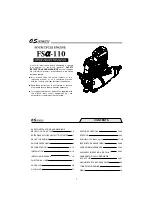
64
1.
Batteries must be heavy-duty and constructed for marine use. They can be either vented/refillable,
maintenance-free, or deep-cycle with a CCA or MICA rating. Refer to
Specifications on pages 95
through 100 for
the correct battery sizes.
2.
Use bolts and nuts to secure battery cables to the battery terminals. Do not use wing nuts to secure battery cables,
even if they were supplied with the battery.
3.
Loose battery connections can cause damage to the engine’s electrical system.
4.
Service electrical components only while the motor is not running. Be careful when identifying positive and negative
battery cables and terminals. If you touch the wrong terminal with a battery cable, even briefly, the motor’s charging
system could be damaged.
The battery terminal connections must always be insulated. If the battery mounting system does not cover the
connections, install protective covers. This will help prevent shorting or arcing at the battery terminals.
Engine start battery
IMPORTANT
It is important that the battery connections are correct. The negative battery cable must be attached to the
negative terminal (–) on the battery, and the engine’s positive cable must be attached to the positive terminal
(+) on the battery.
Use a 12-volt battery with the following specifications:
•
a minimum 650 Cold Cranking Amp (CCA) rating at 0° F (-18° C)
•
165 minutes reserve capacity rating at 89° F (27° C).
Fumes vented during battery charging may cause an explosion.
•
Do not expose battery to electrical sparks or an open flame.
•
Do not use jumper cables and a booster battery to
start engine.
•
If the battery compartment is not properly ventilated, remove battery from boat to recharge.
If the battery has become discharged (“dead”) for no apparent reason, check all electrical system components for
malfunction, or for a switch left in the ON position, before installing a recharged battery.
Failure to follow the safety precautions below may result in electrical sparks igniting fuel vapors causing fire
or explosion.
•
Operate the boat’s bilge blower for at least 5 minutes. Open the engine cover or hatch and check the
boat’s bilge area for gasoline fumes. If any fumes can be detected by smell, do not operate the boat until
you find the source, clean up the spill, and correct the cause.
•
Do not connect cables to battery until all other electrical connections have been made.
7797286 - Downloaded from www.volvopenta.com 19/05/2015 19:28:09
Summary of Contents for 3.0 GS
Page 1: ...1 OPERATOR S MANUAL 3 0 GS 4 3 GL Gi 5 0 GL Gi 5 7 GS GSi 7 4 Gi GSi 8 2 GSi DPX 385 415 ...
Page 2: ...2 7797286 Downloaded from www volvopenta com 19 05 2015 19 28 09 ...
Page 4: ...4 7797286 Downloaded from www volvopenta com 19 05 2015 19 28 09 ...
Page 16: ...16 7797286 Downloaded from www volvopenta com 19 05 2015 19 28 09 ...
Page 20: ...20 7797286 Downloaded from www volvopenta com 19 05 2015 19 28 09 ...
Page 42: ...42 7797286 Downloaded from www volvopenta com 19 05 2015 19 28 09 ...
Page 84: ...84 7797286 Downloaded from www volvopenta com 19 05 2015 19 28 09 ...
Page 86: ...86 7797286 Downloaded from www volvopenta com 19 05 2015 19 28 09 ...
Page 94: ...94 7797286 Downloaded from www volvopenta com 19 05 2015 19 28 09 ...
Page 95: ...7797286 Downloaded from www volvopenta com 19 05 2015 19 28 09 ...
Page 96: ...7797286 TX English 03 2000 AB Volvo Penta SE 405 08 Göteborg Sweden www volvopenta com ...
















































